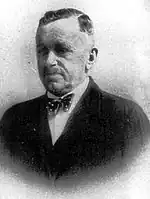鋼和泰
鋼和泰(德語:,俄語:,1877年—1937年),波羅的海德國人,俄國男爵,漢學家、梵語學者。後寓居中國燕京,任教於北京大学,著名學者陳寅恪與胡適都曾跟從鋼和泰學習梵文。[1][2][3]
| 鋼和泰 男爵 | |
|---|---|
 | |
| 出生 | 1877年1月1日 (今屬愛沙尼亞) |
| 逝世 | 1937年3月16日(60歲) |
| 母校 | 多爾帕特大學 柏林大學 哈佛大學 哈雷-维滕贝格大学 |
| 机构 | 北京大學 |
| 研究领域 | 漢學、梵文 |
| 配偶 | 奥尔嘉·冯·格瑞夫()(1929年结婚) |
生平
出生于爱沙尼亚的波羅的海德意志人貴族家庭:父亲奥古斯都·冯·施泰爾-霍尔斯泰因男爵,與杰曼·德·斯戴尔有親戚關係;母亲卡特琳娜·冯·德尔帕荷伦。少年即學習德语和法语。1886年被送到爱沙尼亚小镇派尔努的高级文科中学读书。
1896年到柏林大学师从韦伯和葛尔德纳,学习梵文和波斯祆教古经。1897年继承爵位,任聖彼得堡大学助理梵文教授。1917年帝俄被推翻之後,流亡中國。
1918年至1929年期間曾任教北京大学,寓居東交民巷,精通梵文、藏文,能熟练运用梵文、藏文和汉文研究《大宝积经》。1923年胡适翻译钢氏著《音译梵书与中国古音》一文,发表在《国学季刊》。[4]1926年出版《大宝积经大迦叶品梵藏汉六种合刊》,引起国际印度学界的瞩目。[5][6]陳寅恪在清華大學任教時,每逢星期六的上午,要進城到東交民巷與鋼和泰學習梵文。[7][8]:107陳寅恪稱其:“学问不博,然而甚精”。[5]1928年,前往剑桥大學,同年,被聘为哈佛中国语言文学访问讲师。1929年9月就任中亚语文学教授(Professor of Central Asian Philology),同年返回北平。與奥尔嘉·冯·格瑞夫結婚。
1936年夏曾访问日本,因健康恶化返回北平。
1937年2月因病就医,血压高达三百二十度,3月16日去世於德國醫院。[9]
部分著作
- Путевые впечатления из Индии. СПб., 1904.
- The Kāçyapaparivarta: a Mahāyānasūtra of the Ratnakūṭa class, edited in the original Sanskrit, in Tibetan and in Chinese, Shanghai: Shangwu Yinshuguan, 1926
- On a Tibetan text translated into Sanskrit under Ch’ien Lung (XIII cent.) and into Chinese under Tao Kuang (XIX cent.), Bulletin of the National Library of Peiping, 1932
- On two Tibetan pictures representing some of the spiritual ancestors of the Dalai Lama and of the Panchen Lama, Bulletin of the National Library of Peiping, 1932
- A commentary to the Kāçcyapaparivarta, edited in Tibetan and in Chinese, Peking: published jointly by the National Library and the National Tsinghau University, 1933
- On a Peking edition of the Tibetan kanjur which seems to be unknown in the West, Peking: Lazarist Press, 1934
- On two recent reconstructions of a Sanskrit hymn transliterated with Chinese characters in the X century A.D, Peking: Lazarist Press, 1934
- Two Lamaistic pantheons, edited with introduction and indexes by Walter Eugene Clark from materials collected by the late Baron A. von Staël-Holstein, Harvard-Yenching Institute monograph series 3 and 4, Cambridge, Mass.: Harvard University Press, 1937
注釋
- 阴海燕. . 西藏民族学院学报(哲学社会科学版) (西藏社会科学院民族研究所). 2012, (1).
- . 西藏大学学报(社会科学版) (西藏大学学报编辑部). 2009, (1).
- 王启龙; 邓小咏. . 中国藏学. 2009, (3) [2022-06-30]. (原始内容存档于2022-07-03).
- . WorldCat.org. 1923年6月30日 [2022年6月30日]. (原始内容存档于2022年6月30日).
- 陈怀宇. . 北京師範大学出版社. 2013年3月1日: 160 [2022年6月30日]. (原始内容存档于2022年6月30日) –Google Books.
- 北京大学光华管理学院. .
- 陳寅恪之女陈流求回忆:“父亲从不满足自己掌握的治学工具,每逢星期六的上午,不分寒暑都进城到东交民巷找一位叫钢和泰的外籍教师,学习梵文。”(《陈寅恪先生编年事辑》,上海古籍出版社1997年版,第77页)
- . 生活·讀書·新知三聯書店. 1991.
- 《胡適日記》,1937年3月16日載:“民国七年,我因Sir Charles Eliot的介绍,请他到北大教梵文,并教印度古宗教史。他的古宗教史是我替他口译的,我们合作两年,我得益不少。我初学梵文,也是跟他学的。他今年僅六十风,他一妻一子。”
參考書目
- 王啟龍:《鋼和泰學術年譜簡編》,中華書局,2008年2月1日,ISBN 9787101057928
- Elisseeff, Serge. . Harvard Journal of Asiatic Studies. 1938, 3 (1): 1–8. JSTOR 2717970.
外部連結
This article is issued from Wikipedia. The text is licensed under Creative Commons - Attribution - Sharealike. Additional terms may apply for the media files.